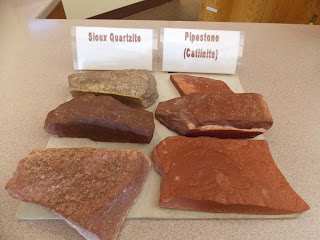We saw the stone pictured above at the Visitor's Center. At the center we also viewed a movie which gave us the story of this park. Unfortunately after George Catlin drew attention to this place, the white man started visiting the quarry and removing the rock. In 1849 a piece of it was sent to Washington D.C. to be put in the Washington Monument. For awhile the land here was part of an Indian reservation, but settlers continued to come in and build it. Large amounts of the rock were also being quarried by the white man until the Indians ceded the land to the government so that it could be protected. In 1937 it became a national park with only Native American tribes allowed to quarry the pipestone. There are 50 quarries in this park.
To the American Indians of the Plains, the pipe has great cultural significance. It is a primary communication between the spirit power and human beings. American Indians believe that when a prayer is given with the smoking of the pipe, those prayers are carried to the Great Spirit with the smoke. White man called it a "peace pipe" because it was smoked during treaty signings. While at the center we watched a Native American carve a pipe.
Pictured below is the final product. We saw a wide variety of pipes at the center's museum which have been carved over the years.
Outside we took the circle trail around the quarries. The prairie around them is absolutely beautiful with a meandering creek and waterfalls. Wildflowers are in bloom and large quartzite cliffs loom over the trail. . I will cover that part of our visit in the next posting. Before I close I want to mention another piece of Native American culture which we saw along the trail. We noticed strips of cloth hanging from trees. A interpretive sign near them noted that the cloth and its color are significant to the wearer who placed them there, they are not to be removed. The piece of cloth represents a prayer or offering.





No comments:
Post a Comment